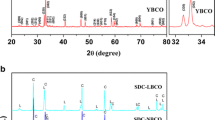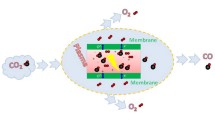Abstract
Mixed conductive oxides are a topic of interest for applications in oxygen separation membranes as well as use in producing hydrogen fuel through the partial oxidation of methane. The oxygen flux through the membranes is governed both by the oxygen ionic conductivity as well as the material’s electronic conductivity; composite membranes like Ce0.8Gd0.2O2−δ (CGO)-CoFe2O4 (CFO) use gadolinium doped ceria oxides as the ionic conducting material combined with cobalt iron spinel which serves as the electronic conductor. In this study we employ ~ 50 nm sputtered CeO2 layers on the surface of porous CGO ceramic substrates which serve as solution “blocking” layers during the thin film fabrication process facilitating the control of film thickness. Films with thickness of ~ 2 and 4 microns were prepared by depositing 40 and 95 separate sol-gel layers respectively. Oxygen flux measurements indicated that the permeation increased with decreasing membrane thickness; thin film membrane with thickness on the micron level showed flux values an order of magnitude greater (0.03 µmol/cm2 s) at 800oC as compared to 1mm thick bulk ceramic membranes (0.003 µmol/cm2).
Similar content being viewed by others
References
Liu, Y.Y., X.Y. Tan, and K. Li, Mixed conducting ceramics for catalytic membrane processing. Catalysis Reviews-Science and Engineering, 2006. 48(2): p. 145–198.
Poulidi, D., C. Anderson, and I.S. Metcalfe, Remote control of the activity of a Pt catalyst supported on a mixed ionic electronic conducting membrane. Solid State Ionics, 2008. 179(27-32): p. 1347–1350.
Dyer, P.N., et al., Ion transport membrane technology for oxygen separation and syngas production. Solid State Ionics, 2000. 134(1-2): p. 21–33.
Kagomiya, I., et al., Oxygen permeable Ce0.8Gd0.2O1.9-CoFe2O4 thin films prepared on porous Ce0.8Gd0.2O1.9 substrates. Electrochemical and Solid State Letters, 2005. 8(1): p. A70–A73.
Kagomiya, I., T. Iijima, and H. Takamura, Oxygen permeability of nanocrystalline Ce0.8Gd0.2O1.9-CoFe2O4 mixed-conductive films. Journal of Membrane Science, 2006. 286(1-2): p. 180–184.
Cheng, S.G., V.K. Gupta, and J.Y.S. Lin, Synthesis and hydrogen permeation properties of asymmetric proton-conducting ceramic membranes. Solid State Ionics, 2005. 176(35-36): p. 2653–2662.
Wagner, C., Z. Phys. Chem. B, 1933. 21: p. 25.
Chen, C.H., et al., Oxygen permeation of La0.3Sr0.7CoO3-delta. Solid State Ionics, 1997. 98(1-2): p. 7–13.
Takamura, H., et al., Oxygen permeation properties of ceria-ferrite-based composites. Journal of Electroceramics, 2004. 13(1-3): p. 613–618.
Takamura, H., et al., Oxygen permeation and methane reforming properties of ceria-based composite membranes. Journal of Alloys and Compounds, 2006. 408: p. 1084–1089.
Author information
Authors and Affiliations
Rights and permissions
About this article
Cite this article
Brinkman, K.S., Iijima, T. & Takamura, H. The Thickness Dependence of Oxygen Permeability in Sol-Gel Derived Ce0.8Gd0.2O2−δ-CoFe2O4 Thin Films on Porous Ceramic Substrates: A Sputtered “Blocking” Layer for Thickness Control. MRS Online Proceedings Library 1126, 1304 (2008). https://doi.org/10.1557/PROC-1126-S13-04
Received:
Accepted:
Published:
DOI: https://doi.org/10.1557/PROC-1126-S13-04




